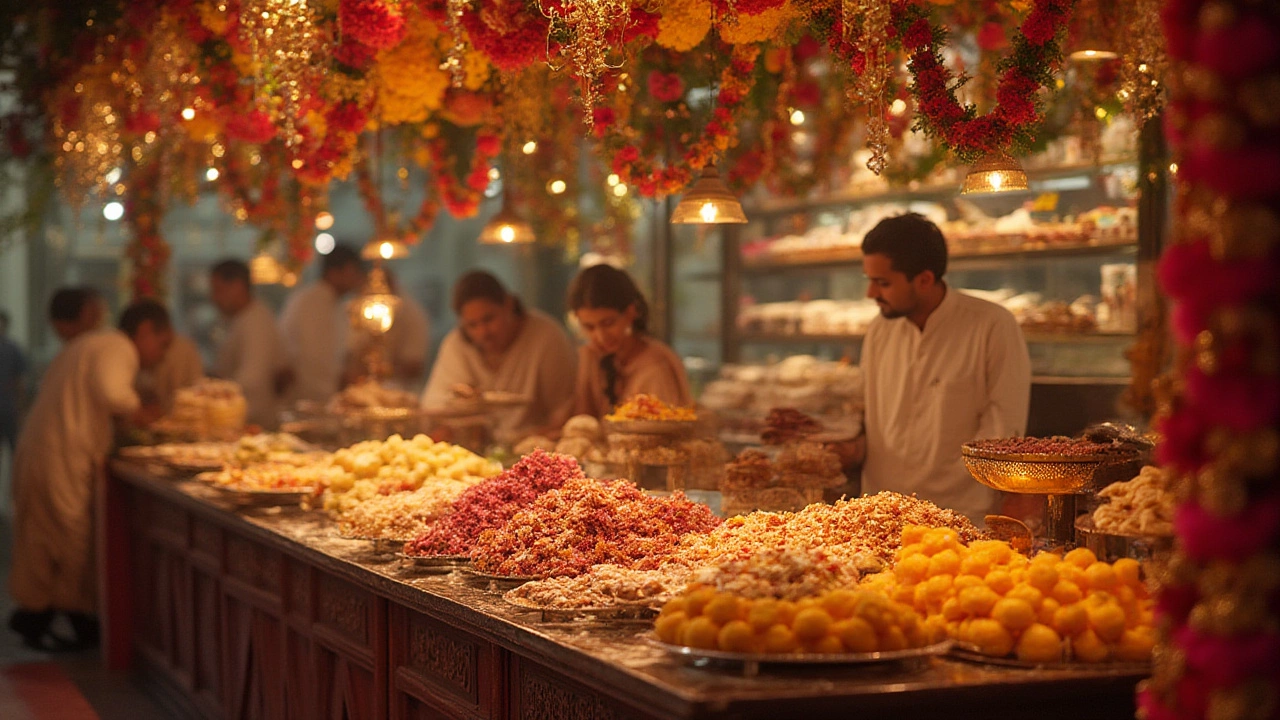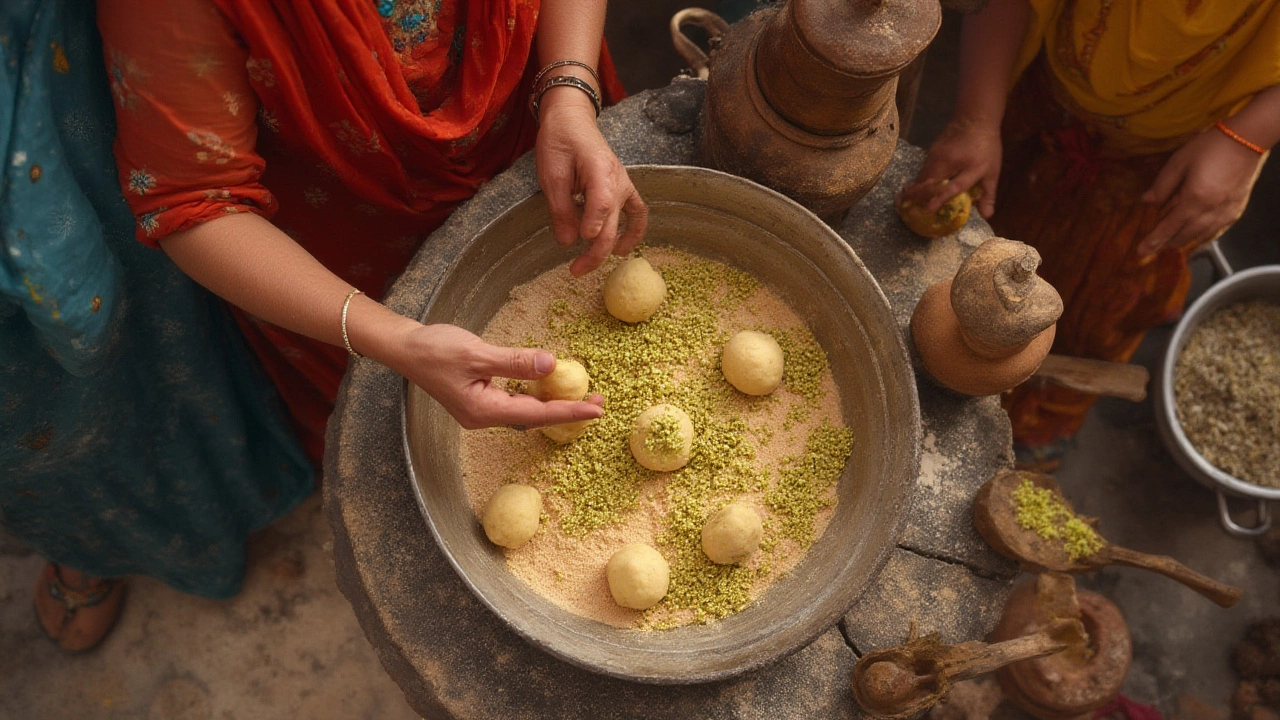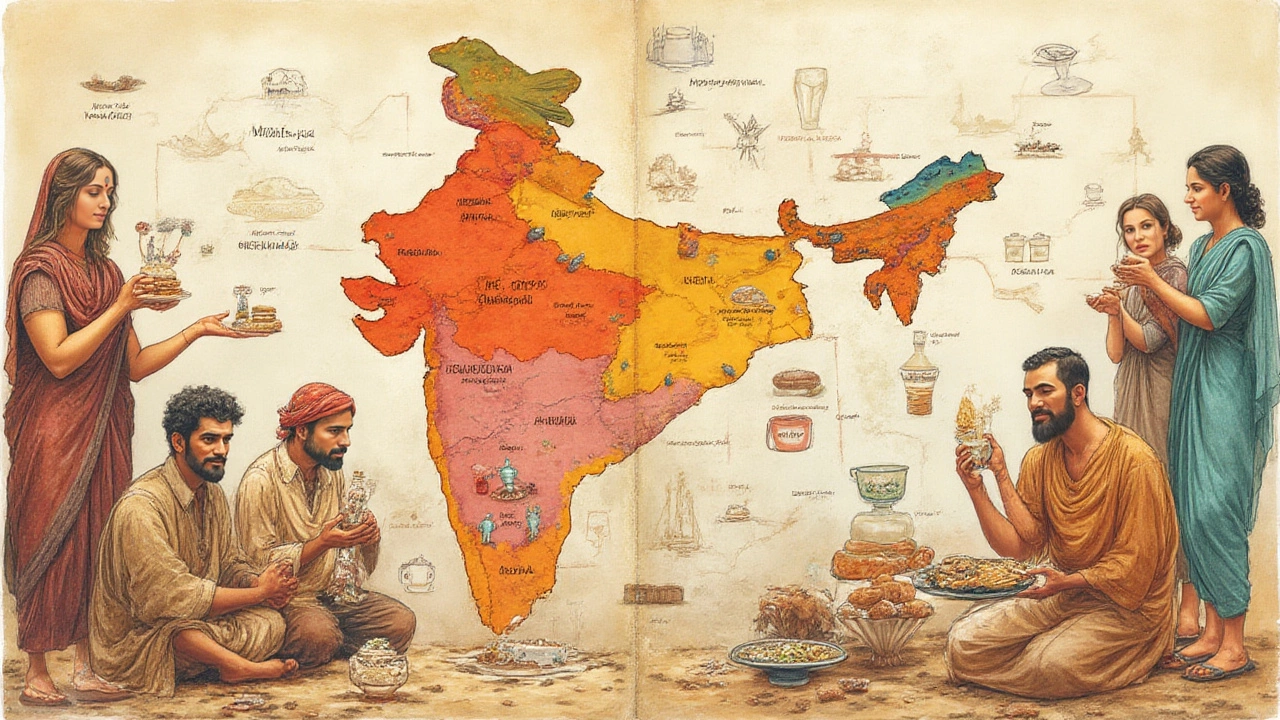What is the Indian Word for Sweet? Unwrapping India's Sweets Language & Traditions
 Jul, 17 2025
Jul, 17 2025
You'd think everyone in India talks about sweets the same way. Not even close. Walk down a street in Delhi and say the word “sweet”—heads might nod, but throw out “mithai,” and suddenly, everyone's got an opinion, a recommendation, maybe even a debate. Here's the crazy thing: In a country where food means everything, just one word for sweet? That's not how India rolls. Names for desserts here have layers—like the flaky soan papdi your uncle swears by, stacked with memories and loaded with meaning.
The Meaning of 'Mithai' and Its Place in Indian Life
So, what's the Indian word for sweet? Most people will tell you it's mithai. But the story doesn’t end there. 'Mithai' comes from the Sanskrit word 'madhur,' which means 'sweet.' Every shop, from Mumbai’s crowded bazaars to tiny corner stores in Kerala, displays 'mithai' in bold, bright letters. You see it during Diwali, Holi, weddings, baby showers—basically, if people gather, there’s mithai. In fact, a 2022 survey said that about 73% of urban Indian households buy mithai at least once a month. It’s tied to celebration, kindness, even deals—nobody seals a big agreement without sharing boxes of barfi or laddus. And forget about showing up at a party empty-handed. That's a crime, really.
But there’s another side. Mithai isn’t just about taste. It stands for hospitality and emotion. Ever heard that in India, every festival begins and ends with something sweet? True story. Serving mithai means, “May your life be full of joy.” Plus, every state uses the word, yet their sweets are as different as chalk and cheese. The famous rasgulla of Kolkata, the melt-in-your-mouth peda from Mathura, or the ghee-packed mysore pak from Mysore itself—they’re all called mithai, but taste and look nothing alike.
Regional Twists: Names for Sweets Across India
If you think every region just says 'mithai,' think again. Step into Punjab, and you'll hear folks say 'mithai,' sure, but also specific names—like 'pinni' or 'patisa.' Down in Tamil Nadu, you’ll hear 'inippu' (pronounced ee-nip-poo), which simply means sweet. Maharashtra uses 'god' (rhymes with road) for sweet, and 'sheera' for semolina pudding. In Bengali-speaking areas, 'mishti' means sweet, and you’ll never win a Kolkata local’s trust if you ask for ‘mithai’ without specifying if you want 'rosogolla' or 'sandesh.' The languages changed, the emotion stuck around.
Here’s something you might not expect. Even the act of giving sweets has its own language. In Gujarat, when someone says, 'meetha khaav cho?' they're not just offering food—they’re checking if you’re happy, healthy, or celebrating. The word itself, whether it’s mithai, mishti, or inippu, comes with mood. And that’s not to mention specialty names. Rajasthan’s 'ghevar,' Goa’s 'bebinca,' Kerala’s 'unniyappam'—the list is wild. If you break it down, India has over 500 named traditional sweets. Staggering, right?
Here’s a quick look at how different regions and languages refer to “sweet”—and what they’re usually eating:
| Region/State | Word for Sweet | Famous Sweet |
|---|---|---|
| Bengal | Mishti | Rasgulla |
| Punjab | Mithai | Pinni |
| Tamil Nadu | Inippu | Mysore Pak |
| Maharashtra | God | Puran Poli |
| Kerala | Maduram | Unniyappam |
| Gujarat | Meethu | Basundi |
Try asking for a local sweet in the language of the state you’re visiting—you’ll probably get a bigger smile and two extra pieces tossed into your box.

History and Cultural Significance of Indian Sweets
The love affair between Indians and sweets goes way back—like, ancient India back. Archaeologists have found evidence that people in the Indus Valley Civilization, around 2500 BC, made sweet treats out of honey and jaggery. Fast-forward to the Vedic period, and ancient texts actually describe dish recipes with sugar, ghee, and grains. It’s wild to think people thousands of years ago were probably arguing over the best recipe for kheer, just like folks do today.
Sweets aren’t just about flavor—they’re about offering prayers and gratitude. In most Hindu temples, devotees offer 'prasadam,' often a sweet like ladoo, to the gods before sharing with others. The history here gets super specific, too. Did you know the iconic 'modak'—a dumpling filled with jaggery, coconut, and nuts—is so tied to Lord Ganesha that many temples in Maharashtra make thousands each Ganesh Chaturthi? And it’s not just a Hindu thing. Muslim families in Hyderabad end Ramadan with 'sheer kurma,' a vermicelli milk pudding; Sikh households hand out 'karah prashad'—a divine halwa—after prayers.
Colonial invaders left their mark. The Portuguese brought 'bebinca' to Goa, while Persians and Arabs influenced milk-based sweets in North India. “Fusion” was a thing before Instagram made it cool. Today, you’ll spot Indian-Americans serving up cupcakes stuffed with gulab jamun or cheesecakes flavored with cardamom. Yet, the roots—offering sweets to celebrate and share—remain the same. That’s why mithai is more than just a word. It’s a cultural handshake, and everyone’s got their way of extending it.
Popular Indian Sweets: A Tour Across the Country
Here comes the fun part—the stuff that makes your mouth water. Each state, each town, maybe even each household, has its favorite sweet. If you visit Agra, you can’t leave without trying 'petha,' a translucent sugar-drenched pumpkin candy. In Chennai, folks will nudge you toward 'mysore pak,' a golden, crumbling block of ghee and sugar. Mumbai offers up 'modaks' and 'shrikhand'—thickened yogurt laced with saffron and pistachios. And let’s not forget 'jalebi,' that coiled, orange syrup bomb eaten everywhere from Gujarat to Uttar Pradesh, and even beyond India’s borders.
What’s fascinating is how some sweets have almost mystical status. Hyderabad’s 'double ka meetha' takes bread pudding to the next level, deep-fried and dunked in sweetened milk. Odisha’s 'chhena poda' literally means “burnt cheese”—a caramelized dessert, so beloved that people travel hours just for a single slice. Even the styles of preparation are their own worlds: steamed (like Bengal’s 'bhapa doi'), fried (like North India’s 'balushahi'), baked, or left to set naturally. Suddenly, choosing a favorite sounds impossible. And don’t think street stalls don’t get in on the action—some of the best sweets in India come from tiny operations, family-run for generations, perfecting the same secret recipe for halwa or barfi for over 100 years.
- Rasgulla (Bengal) – Soft cheese balls in sweet syrup
- Kaju Katli (Pan-India) – Diamond-shaped cashew fudge
- Gulab Jamun (Pan-India) – Fried dough balls in rose-flavored syrup
- Jalebi (North and West India) – Deep-fried spirals soaked in sugar
- Mysore Pak (South India) – Ghee, chickpea flour, and sugar block
- Sandesh (Bengal) – Light, fresh paneer sweet
When you taste a new mithai, you taste years of tradition—and you'll always get a story with every bite. If you’ve ever wondered why so many Indian sweets are milk-based, it’s because for centuries, dairy was the luxury ingredient, shared only at the most important moments.

Tips to Enjoy, Gift, and Make Mithai at Home
Ever found yourself holding a box of mithai, clueless about what’s inside? Here’s a tip: Most boxes have a little map on the underside showing which sweet is which—handy for newbies. If you’re buying mithai for someone, try to ask about allergies or preferences. Not everyone loves pista, and some folks can’t stand coconut. A lot of shops will throw in a couple extra pieces if you ask nicely, especially if you wish them “Shubh Diwali” or “Eid Mubarak.”
Gifting mithai works any time—new jobs, exam results, housewarming, or even just saying thank you. Wrap the box in colored foil or tuck a jasmine garland on top for extra flair. For travel, the top picks are barfi, peda, or kaju katli, which don’t spoil fast. Sweets like creamy ras malai or rabri? Better eaten fresh, or with an ice pack handy.
Making mithai at home doesn’t have to be intimidating. Start simple: try 'suji halwa' or 'coconut ladoos,' which need just five ingredients and less than 30 minutes. If you mess up, don’t stress. In India, a slightly crumbly barfi is called 'halwa,' proving that most mistakes are just a new sweet in disguise. Want to switch things up? Replace sugar with jaggery or honey for a distinct flavor, or toss in dried fruits or cardamom for a punch. For a healthy twist, replace ghee with coconut oil or use low-fat milk. Pro-tip: always taste the syrup before dunking your sweets into it—too thick and your gulab jamun hardens, too thin and you end up with a squishy mess.
And here’s a secret: sweets shared with friends and family always taste better. So, whether you say 'mithai,' 'mishti,' or anything else, one thing’s the same—it all means celebration.
